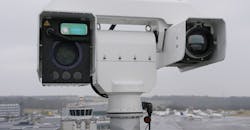The ever-increasing need for efficiency and cost savings in the air traffic domain are motivations for embracing safer and lower cost alternatives like remote tower to reduce air traffic delays and increase safety. In Europe, remote towers are already a reality but in the United States there are still steps to be taken.
The concept of carrying out air traffic control services from any location using a multitude of local sensors, visual and infrared cameras and surveillance solutions creates an exciting opportunity to change the way air traffic is monitored and managed. Advanced video processing with machine intelligence such as deep learning and artificial intelligence makes airports of any size smarter. This solution offers enormous potential in terms of process optimization, utilization of resources and functional synergies across multiple airport locations.
Increased safety, lower costs
In the United States, a number of aerodromes are uncontrolled and operated as so-called “non-towered” airports while still receiving airline services. Across the country services vary from towered at major airports to non-towered at smaller, regional ones with typically lower traffic volume. Of the small airports that have tower control, these will be served by federal contract towers, approved by the FAA, and then operated by private companies. The FAA will only approve contract towers if the benefit exceeds the costs. According to Reason.org, 189 operational contract towers risked being shut down in 2013, however Congress approved emergency funds from the FAA’s airport grants program, allowing them to continue operation. The 2017 article noted that there were 16 small airports still on the waiting list for control towers.
The truth is that a lot of smaller and regional airports worldwide are frequently failing to achieve profits and sometimes even operating at a loss. This is driven by a mix of increasing requirements and higher costs for staffing and technical equipment. Increasing competition, from other airports or other modes of transport, such as trains put these locations at risk for closure if the cost of operations cannot be justified. Tightened state budgets in the United States mean that the majority of publicly owned airports are managed by arms-length organisations that need to break even.
Here is where the argument for remote tower really shows the benefit outweighing the cost. Instead of the cost involved in constructing and maintaining a tall, concrete, control tower at the airport to house equipment and controllers; with the remote tower concept a number of high definition, infrared cameras and communication technology just need to be mounted on masts at the airport and communicate to controllers in a remote tower control facility that offers a panoramic display of the airfield. Additionally, the idea that a number of airports can be served and consolidated into one remote tower center also offers additional cost benefits. There will still be one controller available for one airport, but the concept increases the flexibility of staffing and will help to make operations more efficient. In air route traffic control centers, sectors are opened and closed in line with traffic demand and weather forecasts. We expect a similar concept of operations (CONOPS) to be implemented in the future for remote tower centers.
Tried and tested
Remote tower tests and validations around the world, have already shown the increased safety benefit of a remote tower center, providing improved surveillance at night and in adverse weather such as rain, fog or snow, thanks to advanced infrared camera equipment, object detection and tracking features. Recent FAA testing at Virginia’s Leesburg Executive Airport, to evaluate the safety and practicality of the remote tower concept, noted particularly that the cost of implementing a remote tower was significantly less than doing a full stand-up tower. Cost factors to consider with a full tower include not only the tower construction itself but also infrastructure such as roads and water.
Remote virtual tower solutions have already been tested and are in use at airports with complex ATC operations in Europe, safely managing instrument flight rules (IFR) and visual flight rules (VFR) operations from remote locations. Frequentis has equipped the airport of Saarbrucken, Germany with remote tower technology, managing approximately 15,000 traffic movements per year for the Deutsche Flugsicherung (DFS), and more airports will follow. A contingency solution is currently being installed at Jersey airport in the UK Channel Islands to provide seamless ATC services at any time, as well as continuity of service in the event of a technical failure or evacuation.
In just the last few days a live example the potential disruption a fire alarm in a tower could cause occurred at Heathrow Airport. 3 A contingency remote tower solution might have averted this level of disruption. At the end of 2017, Airways New Zealand selected the solution to demonstrate how the safety and efficiency of tower ATC operations could be enhanced with remote tower, including improved visualization in bad weather and extended hours of service at regional locations.
Research and reliability
Although this topic is starting to gain support in the United States, it still needs to be tested and accepted to receive FAA certification. In order to explore the topic further two private and state government funded remote tower projects are already under way, one at Leesburg, Virginia and one at Fort Collins, Colorado. The FAA has now budgeted to explore this topic even further, setting aside $5 million from the congress budget to begin a FAA remote towers program, requiring the deployment of remote towers to at least two additional airports.
FAA Associate Administrator for Aviation Safety Ali Bahrami noted the inevitability of remote towers at the MRO Americas conference in Orlando in April, highlighting that the challenge will be in providing the same level of visibility and awareness as physically sitting in the tower at the location. Extensive research and implementation is already ongoing worldwide and the FAA will have the opportunity to use those examples and test those procedures in their own conditions.
Frequentis is active in the evolution of remote and digital towers across the world, through involvement in major programs such as SESAR and FAA's NextGEN, and by driving standardisation, e.g. via EUROCAE working group 100.
What’s also important to take into account with a remote tower visual representation of an airfield is the critical need for consistent and reliable network performance, ensuring there is no interruption in voice/data transfer or image quality. Many conventional networks only react to total link loss or black-outs. Technology is available that detects any degradation in network performance, known as brown-out detection and is then able to compare other network conditions and reroute network traffic, ensuring the service continuity and performance required of an ATM-grade network.
Future expansion
In Europe the SESAR 2020 effort has taken the remote tower solution a step further by conducting two multiple remote tower validations for three airports. The simulation exercises were carried out at the DLR Air Traffic Validation Center in Braunschweig, Germany and show that it is possible for a single air traffic controller to safely provide air traffic control services remotely to more than one airport. In a human-in-the-loop, real time simulation, seven Hungarian civil and military controllers managed up to 30 movements per hour at three Hungarian airports, Budapest, Papa and Debrecen.
DLR researchers and Frequentis human factors experts assessed the controllers’ line of sight, their perceived situation awareness, workload and acceptance as well as efficiency and safety while handling the various traffic situations. This allowed for a review of the overall operational feasibility of the concept, as well as agree on the design of the controller working position.
One possible future use case with the potential for further efficiency increases, is the simultaneous operation of multiple towers. The increased adoption of remote tower technology and the digitalization of tower ATC operations have the potential to enable ATC operations to evolve with concepts such as machine learning.
Remote Tower operations have also led to new requests for legal audio and video recording. As critical decision making starts to take place on TV screens rather than a controller’s line of sight a solution such as Frequentis’ DIVOS would be a suitable add on for remote tower, collecting and archiving not only phone and radio communication, but also capturing screens, giving operators and investigators easy access to securely stored information. This can not only aide incident investigation, but also enable training activities.
In a safety-critical world, security must be considered in the DNA of all solutions. Without secure communications and data sharing, there is no safety. Making all information digital, including flight strips, weather and traffic information, as well as voice communication and images, paves the way for further enhanced or new operational concepts that will drive safety and efficiency, allowing increased automation of tasks, better usability, and in turn improved situational awareness for controllers.
Markus Klopf, Director of Strategic Marketing, ATM has 20+ years of global business experience mixed with a creative mindset to strive for new solutions and a passion for strategic thinking and sustainability. He works within the fields of in international B2B marketing and sales, creating innovation in air traffic management, and to create a better world and is a regular speaker and moderator at International industry conferences and events.
About the Author

